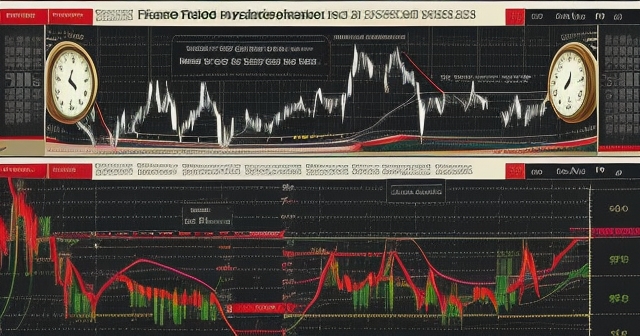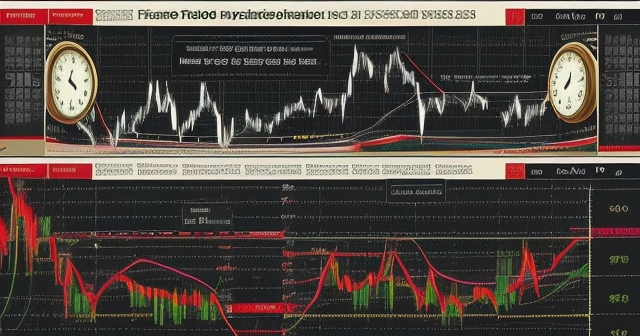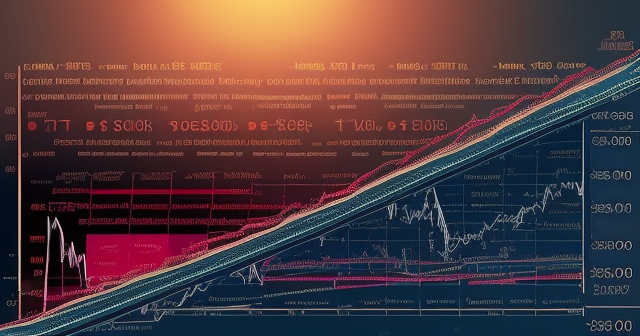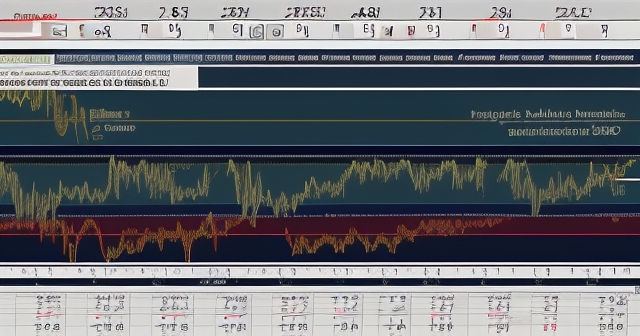
S&P 500 Chart with Historical Events: How Decades of Data Shape Market Dynamics
Table of Contents
ToggleDecades of Data: Navigating S&P 500 History and Recent Volatility
The S&P 500 index isn’t just a number you see on financial news; it’s a dynamic reflection of the collective performance of 500 of the largest publicly traded companies in the United States. For many investors and traders, it serves as the primary benchmark for the overall health and direction of the U.S. stock market. Understanding its movements, both over the long haul and in the throes of daily fluctuations, is absolutely critical. But the chart itself only tells part of the story, doesn’t it? To truly grasp why the S&P 500 behaves the way it does, we need to look beyond the lines and bars and delve into the economic forces, policy decisions, and historical events that have shaped its trajectory over nearly a century.

Think of the S&P 500 chart as a complex tapestry woven from countless threads of economic cycles, technological revolutions, geopolitical shifts, and the intricate dance between corporate performance and investor sentiment. For the technical analyst, the patterns on the chart – the trends, support and resistance levels, volatility swings – are the primary focus. Yet, for a deeper, more resilient understanding, especially crucial for navigating uncertain times, we must contextualize these patterns within the broader fundamental and macroeconomic landscape. Whether you’re just starting your investment journey or you’re a seasoned trader refining your technical strategies, integrating historical perspective with an analysis of present-day drivers will significantly enhance your ability to interpret the S&P 500’s language.
- The S&P 500 index represents a broad spectrum of the U.S. economy.
- Market behavior is influenced by economic cycles, policy changes, and historical events.
- Understanding chart patterns is essential for effective technical analysis.
| Year | Annual Return (%) | Significant Event |
|---|---|---|
| 1931 | -47.07 | Great Depression |
| 1933 | 46.59 | Market Recovery |
| 2008 | -38.49 | Global Financial Crisis |
A Long-Term Tapestry: Unraveling S&P 500 Historical Performance
Looking at the S&P 500 chart over decades paints a powerful picture of wealth creation and resilience. Since its inception (in various forms) leading up to the modern 500-company index in 1957, the index has demonstrated a remarkable upward bias over the long term. This isn’t to say it’s a smooth ride; far from it. The historical data reveals dramatic swings, periods of euphoric growth, and painful contractions that have tested the mettle of investors across generations. Let’s consider some notable periods from the historical record you’ve likely seen or studied.
The early years, including the devastating impact of the Great Depression in the 1930s, show steep declines, with years like 1931 registering a staggering -47.07% annual loss. Yet, even within that tumultuous decade, there were years of significant recovery, such as the remarkable 46.59% gain in 1933 and 45.02% in 1954 (post-WWII recovery). These early data points highlight a fundamental truth: markets are cyclical, and even severe downturns are typically followed by periods of recovery and growth. Understanding these cycles helps manage expectations and provides a crucial perspective against short-term market noise.

Fast forward through the post-war boom, periods of inflation in the 1970s, and the robust growth of the late 20th century fueled by technological advancements and globalization. The 1990s, for instance, saw several years of exceptionally strong double-digit gains, reflecting a period of innovation and economic expansion. But history reminds us that excess can lead to corrections. The dot-com bubble burst in the early 2000s brought significant drawdowns.
Perhaps one of the most vivid recent examples in collective memory is the Global Financial Crisis (GFC) of 2008, where the index plummeted by 38.49%. This period, driven by failures in the financial system, underscores the vulnerability of the market to systemic risks. However, the subsequent decade saw a powerful bull market, often referred to as the “longest bull market in history,” demonstrating the market’s capacity for recovery when supported by monetary policy and economic healing. The journey through these historical periods, with their unique economic backdrops, provides invaluable context for understanding the S&P 500’s behavior. It teaches us that volatility is a feature, not a bug, and that long-term returns are earned by navigating these inevitable ups and downs.
Decades of Data: Peaks, Troughs, and the Cycle’s Rhythm
Let’s dig a little deeper into some specific data points to truly appreciate the amplitude of the S&P 500’s historical swings. As we noted, the 1930s were marked by unprecedented volatility. The rebound of 46.59% in 1933 from the depths of the Depression wasn’t just a recovery; it was a powerful testament to the market’s ability to price in future potential, even amidst ongoing economic hardship. Contrast this with the deep losses of 1930 (-29.63%), 1931 (-47.07%), and 1932 (-16.42%). This era vividly illustrates the concept of mean reversion over the very long term, even if the path is incredibly uneven.
| Year | Annual Return (%) | Significant Event |
|---|---|---|
| 1954 | 45.02 | Post-WWII Recovery |
| 1995 | 34.11 | Tech Boom Begins |
| 2000 | -10.14 | Dot-com Bust |
Moving into the post-WWII era, the market benefited from industrial growth and consumer expansion. Years like 1954 (45.02%), 1958 (38.06%), and the consistent gains of the 1960s (barring a few flat years) show how periods of economic prosperity translate into strong market returns. The late 20th century bull run is also striking, with annual gains exceeding 30% multiple times in the 1990s (1995: 34.11%, 1997: 31.01%, 1998: 26.67%). These were years characterized by optimism, technological enthusiasm (which arguably led to a bubble), and favorable economic conditions.
Then came the shocks of the 21st century. The losses around the dot-com bust (2000: -10.14%, 2001: -13.04%, 2002: -23.37%) were significant, wiping out much of the late 90s gains for those invested at the peak. The 2008 financial crisis, as mentioned, was a severe systemic shock. More recently, 2022 delivered a sharp -19.44% decline, primarily driven by aggressive monetary policy tightening to combat surging inflation. These varied examples from different historical periods underscore that while the long-term trend is upward, the journey is punctuated by significant, often sharp, declines driven by diverse catalysts – from economic depressions and financial crises to asset bubbles and policy shifts.
Studying these historical peaks and troughs isn’t just an academic exercise; it helps us understand the magnitude of potential drawdowns and the resilience required for long-term investing. It reminds us that market cycles are inherent, and while technical analysis can help identify trends within these cycles, a fundamental understanding of their historical context provides a crucial foundation.
Zooming In: Navigating Recent S&P 500 Volatility (Early 2023 Focus)
While long-term historical data gives us perspective on cycles and magnitudes, the day-to-day and week-to-week movements are what traders and active investors grapple with constantly. The period from early 2022 through early 2023 provides an excellent case study in how quickly market sentiment can shift and how sensitive the S&P 500 is to incoming information. After the significant decline in 2022, early 2023 showed signs of recovery, but this recovery was far from a smooth ascent. Daily trading data from this period reveals a landscape dominated by volatility, sharp intraday reversals, and reactions that sometimes seemed counterintuitive based on traditional economic interpretations.
Unlike the annual data which smooths out daily noise, recent daily data allows us to see the immediate impact of specific news events or data releases. A seemingly positive economic report, like strong retail sales or low jobless claims, could paradoxically trigger a sell-off. Why? Because in an environment dominated by fears of persistent inflation and a hawkish central bank, strong economic data is often interpreted as fuel for the Federal Reserve to continue or even accelerate its interest rate hikes. Conversely, weaker data might be cheered as it increases the probability of the Fed pausing or pivoting its monetary policy. This dynamic creates a market where the immediate reaction to news can be counterintuitive, reflecting the primacy of monetary policy expectations in driving short-term moves.

Understanding recent volatility requires analyzing not just the price changes but also the trading volume and how the index behaves around key news releases or specific times of day (like the release of economic reports or Fed announcements). These granular details are crucial for technical traders seeking to identify short-term trends, support/resistance levels, and potential breakout or breakdown points. The early part of 2023 was a period where market participants were acutely focused on deciphering the Fed’s intentions and the trajectory of inflation, making the index highly susceptible to headline risk.
The Daily Pulse: Catalysts Behind Short-Term Swings
Let’s hone in on the types of catalysts that were driving the daily movements of the S&P 500 in early 2023, as indicated by the provided news context. This period was characterized by a relentless focus on macroeconomic data and central bank communication. Market participants were, in essence, glued to every whisper from the Federal Reserve and every piece of economic data released. Specific events stand out:
- Inflation Reports (CPI, PCE): These were arguably the most significant drivers. A Consumer Price Index (CPI) or Personal Consumption Expenditures (PCE) report showing inflation hotter than expected would almost certainly lead to a market sell-off. This wasn’t just about the current inflation rate, but what it implied for future Fed policy. Sticky inflation meant the Fed would likely need to keep rates higher for longer, increasing the risk of an economic downturn or impacting corporate profitability.
- Federal Reserve Communications: Any speech by a Fed official, the minutes from a Federal Open Market Committee (FOMC) meeting, or testimonies before Congress were dissected for clues about the future path of interest rates. A “hawkish” tone (suggesting a preference for tighter policy) would weigh on the market, while any hint of a potential pause or “pivot” (a shift towards easier policy) could trigger a rally. The release of Fed Minutes was a particularly key event, offering detailed insight into the policymakers’ discussions and biases.
- Jobless Claims Data: Counterintuitively, strong labor market data, such as a significant drop in jobless claims, could be seen negatively by the market. Why? Because a robust job market suggests that the economy can withstand higher interest rates, potentially empowering the Fed to continue hiking without causing a rapid increase in unemployment. This reinforces the “sticky inflation” narrative and the likelihood of further tightening.
- Retail Sales: Strong retail sales numbers, indicating resilient consumer spending, also fit into this pattern. While good for the economy in principle, in a tightening cycle focused on curbing demand to fight inflation, strong consumer activity could signal that the Fed’s actions haven’t yet significantly cooled the economy. This, again, might lead to expectations of continued rate hikes.
- Corporate Earnings Reports: While macro dominated, individual company earnings reports still played a crucial role, especially for major constituents of the S&P 500. Strong or weak results from bellwether companies or those representing key trends (like AI with Nvidia, or consumer health with Walmart/Home Depot) could influence sentiment for their sector and potentially spill over to the broader index.
These examples illustrate how, in certain market regimes, the traditional interpretation of economic data can be inverted. Good economic news can be bad for stocks if it implies tighter monetary policy, and vice-versa. This makes navigating such periods particularly challenging and highlights the need for traders to understand the prevailing market narrative – in this case, the overwhelming focus on inflation and Fed policy.
The Federal Reserve’s Shadow: Interest Rates, Inflation, and Market Reaction
It’s impossible to discuss the S&P 500’s recent behavior without giving paramount importance to the actions and communications of the Federal Reserve. The central bank holds immense sway over financial markets primarily through its control over the federal funds rate, which influences borrowing costs throughout the economy. When inflation surged to multi-decade highs, the Fed embarked on an aggressive campaign of interest rate hikes and quantitative tightening (reducing its balance sheet) to cool the economy and bring price levels back down towards its 2% target. This shift from a prolonged period of ultra-low interest rates and quantitative easing fundamentally altered the market environment.
Higher interest rates make borrowing more expensive for companies, potentially reducing investment and impacting future earnings. They also make bonds and other fixed-income assets relatively more attractive compared to stocks, especially growth stocks whose valuations often depend heavily on future projected earnings discounted back at a higher rate. This explains why growth-oriented sectors often suffer disproportionately in a rising rate environment. Furthermore, tighter monetary policy is designed to slow economic activity, increasing the risk of a recession.
The market’s reaction to Fed actions and signals is highly sensitive. Each interest rate hike or confirmation of a “hawkish” stance typically leads to downward pressure on stock prices as investors adjust their expectations for future growth and profitability in a higher-rate environment. Conversely, any indication that the Fed might slow the pace of hikes, pause, or eventually cut rates (a “pivot”) can fuel significant rallies, as borrowing costs decrease and the prospect of looser financial conditions emerges. This sensitivity means that even subtle language changes in Fed statements or nuances in meeting minutes can trigger substantial market moves.

Inflation data, particularly the Consumer Price Index (CPI) and Personal Consumption Expenditures (PCE) index, serves as the primary scorecard for the Fed’s fight against rising prices. When inflation reports come in hotter than expected, it confirms the challenge of bringing prices down and often reinforces the market’s expectation that the Fed will need to remain aggressive with rate hikes. This leads to the concept of “sticky inflation” – prices that aren’t falling back down easily – which is a major concern for the Fed and a negative signal for the market regarding future policy ease. Understanding this direct link between inflation data, Fed policy expectations, and S&P 500 movements is crucial for anyone trading or investing in this environment.
Parsing the Economic Landscape: Recession Fears and Landing Scenarios
Beyond just reacting to data and policy statements, the S&P 500 is also influenced by forward-looking expectations about the overall health of the economy. In early 2023, a dominant theme in financial discussions was the potential for a recession and what economists referred to as various “economic landing” scenarios. These concepts are critical because the performance of the 500 largest U.S. companies is inherently tied to the strength of the U.S. economy.
A recession, typically defined as a significant, widespread, and prolonged downturn in economic activity, usually has a negative impact on corporate earnings and consumer spending, leading to declines in stock prices. Given the rapid pace of interest rate hikes, many analysts and market participants were on “recession watch,” constantly evaluating incoming data for signs of economic weakening. Indicators such as manufacturing data, service sector surveys, and the shape of the yield curve (specifically, an inversion where short-term Treasury yields are higher than long-term yields) are often closely watched as potential recession predictors.
The discussion of economic landing scenarios adds nuance to the recession debate. Analysts debated whether the economy would experience a:
- Hard Landing: This implies a significant economic downturn or recession triggered by the Fed’s aggressive tightening. In this scenario, the S&P 500 would likely face substantial downside risk as earnings deteriorate.
- Soft Landing: This is the ideal scenario, where the Fed successfully cools inflation through rate hikes without causing a recession or significant increase in unemployment. The economy slows, but avoids a severe downturn. In this case, the S&P 500 might experience a moderate correction or even resume an upward trend as uncertainty decreases.
- No Landing: This scenario suggests the economy remains surprisingly strong despite the rate hikes, possibly requiring the Fed to hike rates even further to curb inflation. While avoiding an immediate recession, this could lead to persistent inflationary pressures and potentially a hard landing pushed further into the future, or a scenario where the market worries about the Fed overshooting.

Commentary from prominent financial figures, like those mentioned in the data context (e.g., Jeffrey Gundlach on a hard landing, Raoul Pal’s views), reflects the diverse perspectives and uncertainty surrounding these scenarios. The S&P 500’s movements in early 2023 were heavily influenced by which “landing” scenario the market was pricing in at any given moment. Positive economic data could support the “no landing” or “soft landing” narrative, while negative data would fuel “hard landing” or “recession” fears. This constant evaluation of the economic outlook creates significant volatility and makes it crucial for investors to understand the potential implications of different economic trajectories for corporate earnings and market valuations.
Labor Market and Consumer Strength: Conflicting Signals
One of the most intriguing aspects of the early 2023 market environment was the complex interpretation of seemingly positive economic data points, particularly those related to the labor market and consumer spending. Traditionally, strong employment figures and robust retail sales are seen as indicators of a healthy, expanding economy, which is typically positive for corporate profits and stock prices. However, in the context of the Federal Reserve’s fight against inflation, these data points took on a different, often negative, connotation for equity markets.
A strong labor market, characterized by low unemployment rates and consistent job growth, suggests that wage pressures might persist, contributing to inflation. Furthermore, a tight labor market gives the Fed more leeway to continue raising interest rates without immediately triggering a sharp rise in unemployment, which is one of the central bank’s dual mandates (maximum employment and price stability). Therefore, a report showing jobless claims remained low or even decreased was often interpreted by the market as a signal that the economy was not cooling fast enough to ease inflationary pressures, thus increasing the probability of further Fed tightening. This expectation of more rate hikes would then weigh on the S&P 500.
Retail sales data follows a similar logic in this specific environment. Strong consumer spending is the engine of the U.S. economy. While healthy consumer activity is generally positive, if it remains too robust when the Fed is trying to reduce aggregate demand to lower prices, it suggests that higher interest rates haven’t yet had their desired effect. A surprisingly strong retail sales report could therefore lead to fears that the Fed will need to be even more aggressive, dampening market sentiment and potentially leading to a sell-off in the S&P 500.
This illustrates a critical point about market analysis: the interpretation of any single data point is highly dependent on the prevailing macroeconomic context and the dominant narratives driving market sentiment. In early 2023, the narrative was firmly centered on inflation and the Fed’s response. Therefore, economic strength was often viewed through the lens of its potential to prolong the tightening cycle, creating a situation where “good news for the economy” could translate into “bad news for the stock market.” This paradox highlights the complexity investors face when navigating data releases and reinforces the need to understand the broader economic picture, not just the raw numbers.
Beneath the Surface: Corporate Earnings and Sectoral Influence
While macroeconomic factors and monetary policy expectations often dominate the headlines and drive broad market swings, we must remember that the S&P 500 is an index composed of 500 individual companies. Their collective performance – measured primarily through corporate earnings – is the fundamental driver of stock valuations over the long term. Earnings reports provide insight into how well these companies are navigating the current economic environment, managing costs, and generating revenue. Ultimately, sustained growth in corporate profits is necessary to support rising stock prices.
In early 2023, as the market grappled with higher interest rates and potential recession risks, investors paid close attention to earnings reports for clues about the impact of these headwinds on profitability. Companies providing strong forward guidance, even if current results were mixed, could see their stock prices rally as investors priced in future resilience or growth opportunities. Conversely, companies warning of slowing demand, rising costs, or shrinking margins would typically see their share prices fall, dragging down the index.
| Sector | Market Influence |
|---|---|
| Technology | High impact due to large market cap companies like Nvidia. |
| Consumer Staples | Essential for economic health insights, affects overall consumer sentiment. |
| Energy | Sensitivity to global oil prices impacts sector performance. |
Specific sectors within the S&P 500 can also play an outsized role, especially in periods dominated by certain themes. The technology sector, for instance, holds a significant weighting in the index. In early 2023, discussions around Artificial Intelligence (AI) began to heat up, leading to significant rallies in companies perceived to benefit from this trend. Nvidia Corp. was a prime example; its strong forecast related to AI demand led to a substantial jump in its stock price, which had a noticeable positive impact on the S&P 500 given its large market capitalization. Similarly, the performance and outlook of other tech giants, like Alphabet (Google) or Amazon, could heavily influence the index’s direction on any given day.
Beyond technology, earnings reports from major companies in other key sectors, such as consumer staples (like Walmart) or home improvement (like Home Depot), provide insight into the health of the consumer and specific parts of the economy. Their outlooks on future sales and profitability can signal broader economic trends. Thus, while we analyze the macro forces driving the S&P 500 from the top down, it’s equally important to understand that the index’s performance is ultimately an aggregation of the performance of its constituent companies. Earnings reports and sector-specific news provide the micro-level perspective that complements the macro view.
Connecting the Dots: Synthesizing Macro and Micro Drivers
So, how do we bring together these seemingly disparate elements – the long arc of history, the relentless focus on daily data, the gravitational pull of the Federal Reserve, the uncertain economic forecasts, and the performance of individual companies? The key lies in understanding that the S&P 500 chart is a dynamic interplay of all these factors, interpreted and priced in real-time by millions of market participants globally. It’s a complex adaptive system where different drivers take precedence at different times.
During periods of relative stability and economic growth, corporate earnings and sector trends might be the primary focus. Analysts pore over balance sheets and income statements, and stock movements are often tied to company-specific news or industry developments. Technical analysis thrives in identifying trends driven by this underlying corporate performance.
However, during times of significant economic uncertainty or major policy shifts, the macro factors tend to dominate. As we saw in early 2023, the market’s sensitivity to inflation data and Fed commentary outweighed many other considerations. In such environments, even strong corporate results might be overshadowed by fears of rising interest rates or an impending recession. The technical patterns can become more erratic, subject to sudden shifts based on macro headlines.
Historical perspective provides the backdrop. It teaches us about the potential magnitude of swings and the cyclical nature of markets. It reminds us that bull markets don’t last forever, nor do bear markets. Understanding past recessions and recoveries helps frame current fears and potential outcomes.
For the technical analyst, this synthesis means recognizing that while chart patterns are powerful tools for identifying trends and potential turning points, understanding the fundamental and macroeconomic drivers can provide crucial context. Are we in a macro-driven environment where trends are more likely to be broken by news headlines? Is the market in a phase where earnings reports will dictate direction? Is the long-term historical trend supporting or conflicting with the current short-term movement? Asking these questions, informed by an understanding of the factors we’ve discussed, can improve the effectiveness of technical analysis and risk management.
Applying the Analysis: Implications for Investors
Understanding the complex interplay of forces that drive the S&P 500 has direct and significant implications for you as an investor or trader. It fundamentally shapes how you should approach market analysis and decision-making. Simply relying on one approach, whether it’s purely technical or purely fundamental, might leave you vulnerable in certain market conditions.
If you are primarily a technical analyst, recognizing the dominance of macro factors in periods like early 2023 is crucial. It means being extra cautious around key economic data releases and Fed announcements, as these events have the power to override established technical patterns. Volatility might increase, and traditional support/resistance levels could be tested or broken more easily. Incorporating macro event risk into your trading plan and risk management strategies becomes paramount. It also suggests that identifying trends fueled by the primary macro narrative (e.g., the initial downtrend driven by rate hike expectations in 2022, or potential shifts based on inflation data) can be more fruitful than focusing solely on patterns independent of the economic context.
For the long-term investor, this analysis reinforces the importance of staying diversified and maintaining a long-term perspective. Historical data clearly shows that the S&P 500 experiences significant drawdowns, but over multiple decades, it has consistently recovered and trended upwards. Trying to time the market based solely on short-term macro noise is notoriously difficult. Instead, focusing on the long-term growth potential of the underlying companies and viewing downturns through the lens of historical cycles can help maintain discipline during volatile periods.
Regardless of your approach, staying informed about the key macroeconomic drivers – inflation, interest rates, economic growth forecasts, central bank policy – is essential. These factors create the environment in which your investments or trades exist. Understanding the potential impact of a hard landing versus a soft landing, or the implications of sticky inflation for corporate margins, allows for more informed decision-making, whether you’re adjusting your portfolio allocation, setting stop-loss orders, or evaluating the conviction behind a technical signal.
Furthermore, recognizing the influence of corporate performance and sector trends means not losing sight of the micro picture. While macro dictates the tide, individual company performance determines which ships float or sink. Understanding where potential growth lies (e.g., in sectors like AI or renewable energy) or where risks might be concentrated (e.g., in highly indebted companies in a rising rate environment) adds another layer of crucial insight to your analysis of the S&P 500 and its components.
The S&P 500: A Complex Adaptive System
We’ve journeyed from the long sweep of S&P 500 history, marked by depressions, wars, booms, and busts, to the intense focus on daily volatility driven by macroeconomic data and central bank whispers. What becomes clear is that the S&P 500 index is not a simple entity driven by one or two factors. It is a complex adaptive system, constantly reacting to a multitude of inputs from global economics, government policy, corporate innovation, and human psychology.
The historical data provides the essential context, showing us the potential range of outcomes over long periods and the cyclical nature of market movements. The recent daily data highlights the sensitivity of the market to immediate catalysts and the sometimes counterintuitive reactions driven by the prevailing narrative (like the good-news-is-bad-news dynamic observed in early 2023 concerning strong economic data). The Federal Reserve and its fight against inflation emerged as the dominant force in the recent period, demonstrating the immense power of monetary policy to influence equity valuations.
Economic forecasts, particularly the debate around recession probabilities and landing scenarios, create significant uncertainty and drive forward-looking market movements as investors attempt to discount future conditions. Finally, the performance of the underlying companies, their earnings reports, and the trends within specific sectors provide the fundamental basis upon which the entire structure rests. It reminds us that ultimately, stock prices reflect the market’s expectation of future corporate profitability.
Successfully navigating the S&P 500, whether as a long-term investor or a short-term trader, requires developing a holistic understanding of these interconnected drivers. It means being able to zoom out to appreciate the historical cycles and zoom in to analyze the immediate catalysts. It involves understanding the mechanics of monetary policy and its impact on valuations, while also tracking corporate performance. It requires humility to acknowledge the inherent uncertainty and adaptability to shift focus as different drivers become more prominent.
By integrating these perspectives – history, macroeconomics, corporate fundamentals, and technical analysis – you can build a more robust framework for interpreting the S&P 500 chart and making more informed decisions in your investment journey. The path is rarely smooth, but armed with this comprehensive understanding, you are better equipped to navigate the volatility and pursue your financial goals.
s&p 500 chart with historical eventsFAQ
Q:What is the S&P 500?
A:The S&P 500 is a stock market index that measures the stock performance of 500 of the largest publicly traded companies in the U.S.
Q:How does historical data impact the S&P 500?
A:Historical data reveals trends, cycles, and significant events that influence market behavior and investor sentiment, helping to inform future expectations.
Q:What are key factors influencing the S&P 500’s movements?
A:Key factors include economic indicators, Federal Reserve policies, corporate earnings, and external events impacting the financial market landscape.
You may also like
Calendar
| 一 | 二 | 三 | 四 | 五 | 六 | 日 |
|---|---|---|---|---|---|---|
| 1 | 2 | 3 | 4 | 5 | 6 | 7 |
| 8 | 9 | 10 | 11 | 12 | 13 | 14 |
| 15 | 16 | 17 | 18 | 19 | 20 | 21 |
| 22 | 23 | 24 | 25 | 26 | 27 | 28 |
| 29 | 30 | 31 | ||||
發佈留言
很抱歉,必須登入網站才能發佈留言。